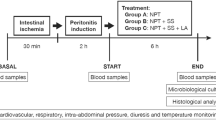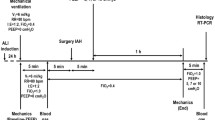Abstract
Background
To examine whether CO2 pneumoperitoneum and positive end expiratory pressure (PEEP) in mechanical ventilation affect the systemic spread of intraabdominal infection.
Methods
Sprague-Dawley male rats weighing 200–300 g were allocated to three groups of 12 animals in each. All rats received mechanical ventilation under general anesthesia. An intraabdominal infection model was established by injecting with 1 ml of Escherichia coli (109 CFU/mL) intraperitoneally. Half of the animals in each group were exposed to PEEP (10 cmH2O). CO2 pneumoperitoneum at 13 mmHg was applied to the rats in group 1. Group 2 rats underwent laparotomy. Group 3 served as controls. In addition, TNF-α serum levels were measured at baseline and 3 h. A peritoneal specimen for histopathological examination were obtained after the rats were killed at the end of 3 h. For the assessment of data, descriptive statistical methods (mean, standard deviation) as well as Friedman test for repeated measurements in multiple groups, Kruskal-Wallis test for intergroup comparisons, Dunn’s multiple comparison test for subgroup comparisons, Mann-Whitney U test for comparisons between paired groups, chi-square and Fisher’s exact test for comparison of qualitative data, and McNemar’s test for assessment of changes in group variables over time were used. The results were considered statistically significant if probability (p) values were <0.05.
Results
Grades of peritonitis in group 1 and 2 were seen to differ nonsignificantly. In group 1, baseline blood cultures were not included in the assessment between the subgroups that received PEEP or not, as there was no growth in any of the subgroups. No significant difference was detected between growth in blood cultures at 1, 2, and 3 h (p > 0.05). Aplication of PEEP in subgroups did not alter the blood culture results (p > 0.05). Significant differences were seen between the initial and final TNF-α values of groups (KW: 18.94, p < 0.0001). The values in control group were observed to be significantly lower than those in groups 1 and 2 (p < 0.01, p < 0.001). Bacteremia and systemic spread of the intraabdominal infection did appear to be different according to the PEEP application. After the assessments of ventilation parameters in our study, significant reductions in pH and HCO3 levels were detected in group 1 as a result of pneumoperitoneum, which was consistent with the literature. There is a significant difference between pH values at baseline and at the end of 1 h because of pneumoperitoneum (Fr: 10.01, p < 0.05). PEEP application in subgroups did not create significant differences in terms of respiratory parameters (p < 0.01).
Conclusion
No difference was found between the applications of CO2 pneumoperitoneum and laparotomy with regard to bacteremia and infection-induced peritonitis. It was determined that pneumoperitoneum along with PEEP application had neither a positive nor a negative impact on intraabdominal infection.
Similar content being viewed by others
References
RJ Baigrie PM Lamont D Kwiatkowski MJ Dallman PJ Morris (1992) ArticleTitleSystemic cytokine response after major surgery. Br J Surg 79 757–760 Occurrence Handle1:STN:280:ByyD3cnps1U%3D Occurrence Handle1393463
C Balague EM Targarona M Pujol X Filella JJ Espert M Trias (1999) ArticleTitlePeritoneal response to septic challenge. Comparison between open laparatomy, pnömoperitoneum laparascopy, and wall lift laparascopy. Surg Endosc 13 792–796
M Bessler RL Whelan A Halverson MR Treat R Nowygrod (1994) ArticleTitleIs immune function better preserved after laparoscopic versus open colon resection? Surg Endosc 8 881–883
C Bloechle A Emmermann H Treu E Achilles D Mack C Zornig E Broelsch (1995) ArticleTitleEffect of a pneumoperitoneum on the extent and severity of peritonitis induced by gastric ulcer perforation in the rat. Surg Endosc 9 898–901
D Collet GC Vitale M Reynolds E Klar WG Cheadle (1995) ArticleTitlePeritoneal host defenses are less impaired by laparoscopy than by open operation. Surg Endosc 9 1059–1064 Occurrence Handle1:STN:280:BymC3MfgvFc%3D Occurrence Handle8553203
E Eleftheriadis K Kotzampassai K Papanotas N Heliadis K Sarris (1996) ArticleTitleGut ischemia, oxidative stress and bacterial translocation in elevated abdominal pressure in rats. World J Surg 20 11–16 Occurrence Handle10.1007/s002689900002 Occurrence Handle1:STN:280:BymC2cfjsVE%3D Occurrence Handle8588401
A Gupta DI Watson (2001) ArticleTitleEffect of laparoscopy on immune function. Br J Surg 88 1296–1306 Occurrence Handle10.1046/j.0007-1323.2001.01860.x Occurrence Handle1:STN:280:DC%2BD3Mrjt1Sguw%3D%3D Occurrence Handle11578282
GC Gurtner CS Robertson SC Chung TKW Ling SM Ip AKC Li (1995) ArticleTitleEffect of carbon dioxide pneumoperitoneum on bactaeremia and endotoxaemia in an animal model of peritonitis. Br J Surg 82 844–848
JJ Haitsma S Uhlig R Goggel SJ Verbrugge U Lachmann B Lachmann (2000) ArticleTitleVentilator-induced lung injury leads to loss of alveolar and systemic compartmentalization of tumor necrosis factor-alpha. Intensive Care Med 26 1515–1522 Occurrence Handle1:STN:280:DC%2BD3M7htlegsQ%3D%3D Occurrence Handle11126266
A Hajri S Mutter D. Wack C Bastien JF Gury J Marescaux M Aprahamian (2000) ArticleTitleDual effect of laparoscopy on cell-mediated immunity. Eur Surg Res 32 261–266 Occurrence Handle10.1159/000008773 Occurrence Handle1:STN:280:DC%2BD3M%2FpvFOiug%3D%3D Occurrence Handle11111169
EJ Hazebroek JJ Haitsma B Lachmann HJ Bonjer (2002) ArticleTitleMechanical ventilation with positive end-expiratory pressure preserves arterial oxygenation during prolonged pneumoperitoneum. Surg Endosc 16 1073–1078 Occurrence Handle10.1007/s00464-001-8248-x Occurrence Handle1:STN:280:DC%2BD38vhtFCqug%3D%3D Occurrence Handle12165825
T Ipek M Paksoy T Colak E Polat N Uygun (1998) ArticleTitleEffect of carbon dioxide pnömoperitoneum on bacteremia and severity of peritonitis in an experimental model. Surg Endosc 12 432–435 Occurrence Handle10.1007/s004649900697 Occurrence Handle1:STN:280:DyaK1c3ktVKhtg%3D%3D Occurrence Handle9569364
CA Jacobi J Ordemann B Bohm HU Zieren et al. (1997) ArticleTitleDoes laparoscopy increase bacteremia and endotoxemia in a peritonitis model? Surg Endosc 11 235–238
EJ Kraut JT Anderson A Safwat R Barbosa BM Wolfe (1999) ArticleTitleImpairment of cardiac performance by laparoscopy in patients receiving positive end-expiratory pressure. Arch Surg 134 76–80 Occurrence Handle10.1001/archsurg.134.1.76 Occurrence Handle1:STN:280:DyaK1M7isVehtA%3D%3D Occurrence Handle9927136
L Linhares H Jeanpierre F Borie A Fingerhut B Millat (2001) ArticleTitleLavage by laparoscopy fares better than lavage by laparotomy. Surg Endosc 15 85–89 Occurrence Handle10.1007/s004640000253 Occurrence Handle1:STN:280:DC%2BD3M7ptlWjtg%3D%3D Occurrence Handle11178770
MM Ozmen C Col AM Aksoy FA Tekeli M Berberoğlu (1999) ArticleTitleEffect of CO2 insufflation on bacteremia and bacterial translocation in an animal model of peritonitis. Surg Endosc 13 801–803 Occurrence Handle1:STN:280:DyaK1MzlvF2itA%3D%3D Occurrence Handle10430689
EA Pullicino F Carli S Poole B Rafferty STA Malik M Elia (1990) ArticleTitleThe relationship between the circulating concentrations of interleukin 6 (IL-6), tumor necrosis factor (TNF) and the acute phase response to elective surgery and accidental injury. Lymphokine Res 9 231–238 Occurrence Handle1:CAS:528:DyaK3cXkt1Wqtrw%3D Occurrence Handle1692598
EL Tsilibary SL Wissig (1983) ArticleTitleLymphatic absorption from the peritoneal cavity: regulation of patency of mesothelial stomata. Microvasc Res 25 22–39 Occurrence Handle1:STN:280:BiyC28nlvVI%3D Occurrence Handle6835097
H Ulla M Nagelschmidt H Troidl (1999) ArticleTitleCO2 pneumoperitoneum: what we know and what we need to know. World J Surg 23 794–800 Occurrence Handle10.1007/s002689900582 Occurrence Handle10415205
DH Wittmann M Schein RE Condon (1996) ArticleTitleManagement of secondary peritonitis. Ann Surg 224 10–18 Occurrence Handle10.1097/00000658-199607000-00003 Occurrence Handle1:STN:280:BymB1cbkslU%3D Occurrence Handle8678610
JM Yoffey FC Courtice (1970) Lymph flows from regional lymphatics. Lymphatics, lymph and the lymphomyeloid complex Academic Press New York 295–315
Acknowledgments
This work was supported by the Research Fund of The University of Istanbul (project number: 1695/15082001).
Author information
Authors and Affiliations
Corresponding author
Rights and permissions
About this article
Cite this article
Barbaros, U., Ozarmagan, S., Erbil, Y. et al. Effects of pneumoperitoneum created through CO2 insufflation and parameters of mechanical ventilation (PEEP application) on systemic dissemination of intraabdominal infections. Surg Endosc 18, 501–507 (2004). https://doi.org/10.1007/s00464-003-9107-8
Received:
Accepted:
Published:
Issue Date:
DOI: https://doi.org/10.1007/s00464-003-9107-8




